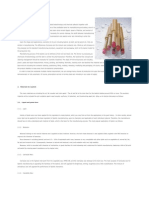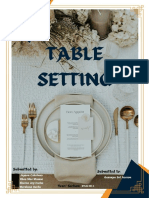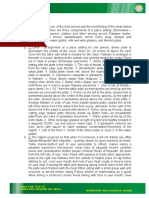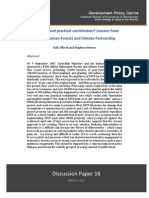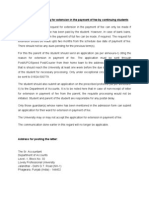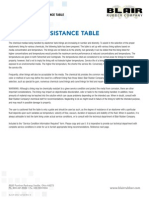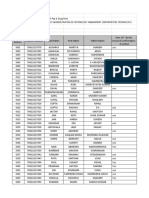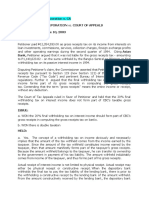Restaurant Operations
Restaurant Operations
Uploaded by
kishorschandranCopyright:
Available Formats
Restaurant Operations
Restaurant Operations
Uploaded by
kishorschandranOriginal Description:
Copyright
Available Formats
Share this document
Did you find this document useful?
Is this content inappropriate?
Copyright:
Available Formats
Restaurant Operations
Restaurant Operations
Uploaded by
kishorschandranCopyright:
Available Formats
Meet demand Judge the demand.
A business must schedule without being understaffed, because a staff shortage can lead to negative customer experiences as consumer demands will not be met successfully or excessive waiting periods may occur. Schedule effectively Overstaffing can be costly, so take this into consideration when you schedule staff. If you pay a number of staff that is unnecessary, it can eat into profits. Plan ahead Plan staff scheduling ahead of time. Not being able to let your staff know in advance when they are expected to work makes you appear unprofessional and also leads to staff having other demands, meaning their attendance is not assured. Considerations Manage your staff as people. Your employees are humans with a number of things going on in their life. You should take these things into account and plan in advance, giving them the time off they need; this is crucial to successful staff management. Software Use software, because many systems are available that can help make staff scheduling easier and more professional. RESTAURANTS OPENING & CLOSING DUTIES MISE EN PLACE AND MISE EN - SCENE An excellent Food and Beverage Outlet must draw an interest their potential customers and also should try to make them their regular or privileged customers. The type of menu, the fascinating name of the place or ambience within the food service area all works in building up the customers interest in any food outlet. As always said that the First Impression is the last impression, it becomes very right in terms of opening, activities that are related to prior service, as well as performing the closing duties effectively. The preparations done prior to the service are known as Mise-en-place which creates the right and pleasing ambience by
adjusting the temperature of a room, dim or bright lighting and setting up of equipment. ORGANIZING FOR SERVICE As every little thing needs planning and then the action comes, in the same way, for providing the best services in food and beverage, organizing the Mise en place and making other arrangements comes in the Planning stage. Pre - Preparation Activities: The service staff should check the following before service: i) The tables and linen are clean. ii) Tablecloths are properly spread on the table. iii) Chairs are clean and properly arranged. iv) The tables are set appropriately and are pleasurable. v) The Silver is polished and the China and Crockery are spotlessly clean. vi) Cruets, sugar bowls and flower vases are filled and placed on the table suitably. vii) The floor / carpet are clean and dry. viii) The side station is fully equipped for service and the following should be checked: Condiments tray is cleaned and refilled. Napkins are folded and kept handy for the particular session. Salvers, extra linen, cutlery and service equipment necessary for the session are stacked up. Water jugs and ice buckets are filled and kept ready. Coffee pots are kept ready with freshly brewed coffee / tea. Sugar cubes, butter and butter plates ready. During Service Preparations: i) Greet: When the guests arrive greet warmly, by wishing them according to the time of the day. ii) Escort: Escort the guests to the table and seat them promptly by pulling the chairs out to ease seating. If need be, the table should be moved so that very little inconvenience is caused to guests when they seat themselves.
iii) Ensure: Ensure that children have high chairs and special attention is paid to the elderly. iv) Remove: Remove extra covers, if any. v) Serve water and present the menu card, if the captain is busy. vi) If the order has to be taken, offer suggestions to the guests on the choice of food and beverages and repeat the final order to avoid possible errors. vii) Do not leave the station unattended viii) If the table cloth has to be changed during service, the table top should not be exposed. Any articles on the table should be cleared to the side station and not placed on chairs or on the next table. The soiled cloth should be brushed using a service cloth and a crumbing tray or plate. ix) Do not neglect little things such as lighting a guest's cigarette, responding to a request and showing interest in the guest's needs. x) Ensure fast service, efficient and pleasant. xi) Before serving dessert, clear and crumb the table. Preparation After Service: i) Pull out the chairs or the table to enable guests to move out comfortably. ii) Wish them warmly and request them to visit again, saying - Do visit again, sir / madam. iii) Clear the table immediately and reset for the next guest. iv) Have the side station cleared and restacked for the next sitting.
MISE-EN-SCENE
Mise-en-scene, the French term means to prepare the ambience of the outlet before service in order to make it pleasant, comfortable and hygienic. Before each service session, the restaurant should be made presentable enough to receive the guests. The supervisor or team of waiters should ensure the following mise-en-scene: Carpets are well brushed or hovered. All tables and chairs are serviceable and properly placed. Table lights or wall lights have functioning bulbs.
Menu cards are presentable and attractive. Tent cards or other sales material are presentable. Doors and windows are thrown open for some time to air the restaurant. This should be followed by closing the windows and doors and setting the air-conditioning or heating to a comfortable temperature. Exchange dirty linen for fresh linen from Housekeeping. Table cloths and mats are laid on the tables. Replace wilted flowers with fresh flowers.
MISE-EN-PLACE Mise-en-place, the French term means to putting in place is attributed to the preparation of a work place for ultimate smooth service A station comprises of a given number of tables which are attended by a given team of waiters. Thus a restaurant may have several stations, each with a team of waiters. In a large restaurant, each station may be headed by a Chef-derang. Mise-en-place involves: Side stations should be stacked with sufficient covers for resetting the restaurant after the first sitting is over. Extra linen, crockery, cutlery, glassware and ashtrays should be kept handy so that they are readily available for use. Cruet sets should be cleaned and filled on a daily basis. Sauce bottles should be filled and the necks and tops of the bottles wiped clean. Butter, condiments and accompaniments for service should be kept ready for use when needed.
TABLE SETTING Table setting refers to the way to set a table with tableware - such as eating utensils and dishware - for serving and eating. The arrangement for a single diner is called a place setting. The rules are followed to facilitate dining and making the table neat. The basic rules for laying the tables are given below:
1) Table Linens: Table linen has to be laid properly. A white cloth is preferred but not mandatory. 2) Napkins: Linen napkins should be folded elegantly and placed in the center of the dinner plate. 3) Silverware: Silverware is to be placed in order of use. In other words, the diner will start from the outside and work his way in. The first course will use silverware farthest from the dinner plate, while the last course will utilize the silverware closest. Place all silverware an inch from the table's edge. 4) Knives: Set knives on the table to the right of the dinner plate. Technically, one should only use a knife if one is cutting meat; however, up to three knives can be placed on the table, in order of use. Blades should face inside, towards the table setting. 5) Forks: Forks are to be set to the left of the dinner plate in order of use. In most cases, there are three: one each for seafood, the main course and the salad. When dining formally, salads are generally served at the end of the meal. 6) Spoons: Spoons are set to the right of the knives in order of use. If there is a dessert spoon,this will be set above the plate. Coffee spoons are set on the saucer when it's time for dessert. 7) Glasses: Glasses are set above the plate to the right in order of use. From left to right: Water glass, red wine glass, white wine glass, champagne flute (if ordered). 8) Dessert: Dessert plates and coffee / tea cups will be set out after dinner. If a fork is to be used with dessert, this will be placed on the dessert plate. A dessert spoon should have already been set above the dinner plate.
Points to Remember When Laying a Table
1) The table on which a tablecloth is to be spread should be first covered with a baize base cloth, for the following reasons: a. To protect the diner's wrists and elbows from the table's sharp edges. b. To keep the tablecloth firmly in place. c. To protect the surface of the table and prevent the rattling of crockery and cutlery. d. To absorb moisture in case liquid spills on the table. 2) Based on the size of the table, appropriate linen should be used. The central fold of the tablecloth should be in the middle of the table and all the four edges should just brush the seats of the chairs. Soiled or torn linen should not be used. Three types of tablecloths namely cotton, linen and damask are used. Of these, damask is the best. 3) If a bud vase is used as a central decorative piece, it should not be very large or tall as that obstructs the view of guests sitting opposite each other. Heavily scented flowers should be avoided, as they affect the flavor of the food. 4) Only the required cutlery, crockery and glassware should be placed on the table. On a normal dining table, the space required for one cover is 60 cm x 38 cm. The cover on the opposite side should be exactly similar, so as to give a wellbalanced look. 6) Cutlery should always be laid from the outside of the cover to inside, since the order of sequence in which they are to be used is always from outside to inside. 7) Knives and soup spoons should be placed on the right-hand side of a cover, while forks should be placed on the left-hand side. Dessert spoons and forks should be placed on top of the cover. The side knife should be placed on a quarter plate and kept on the left side of the cover. The cutting edge of all knives should face to the left. 8) Water tumbler should be kept to the right of the cover, at the tip of the large knife.
9) Napkins should be placed in the centre of the cover, in between the cutlery. Normally during a dinner session, napkins are arranged in empty water tumblers. 10) Cruet sets, a butter dish, an ashtray, meal accompaniments and a bud vase should be placed in between the covers at the centre of the table. 11) Crockery and cutlery should be spotlessly clean and the glassware well-polished. 12) Chipped or cracked equipment should not be used. The hotel's monogram should be visible to the guest. 13) All cutlery and crockery should be placed about an inch from the edge of the table so that they are not accidentally tipped over.
Money Managers must handle the money in a restaurant according to procedure each day. On opening shifts, a manager should count the safe to determine the amount of money in the building, fill each register drawer and make the first deposit of the day. At closing, she will count out all drawers to close the accounts, count the safe a final time and lock down all the cash in the building. Food Prepare food in a timely manner at opening and closing for the most efficiency throughout the day. At opening, the crew must do all the prep work for the first half of the day. Whether fast food or high-end cuisine, all restaurants prep some foods ahead of time. At closing, the crew must safely store all edible leftover food in appropriate containers for it to be used the next day. Cleaning Opening shift team members often perform heavy-duty extra cleaning tasks, as these are easiest done before the restaurant opens. Do cleaning jobs like scrubbing lobby floors, cleaning ovens and emptying and cleaning freezers in the morning. Daily cleaning jobs most often fall on the closing shift. While team members should clean throughout the day, the entire
restaurant should be cleaned and straightened before closing staff lock the doors for the night. Lobby and Dining Room The opening shift is responsible for setting up the lobby and dining room. Set tables, straighten furniture, clean windows and do any other task to make this area ready for customers. After the restaurant closes, the night shift should stack chairs, sweep and mop and do anything else needed for a clean lobby ready for the morning. Paperwork No successful restaurant can run without accurate paperwork being done throughout the day. The opening manager should set up all necessary files for the day, including safe logs and register files. The closing manager is responsible for the final paperwork of the night, which may include inventory, cash control and food cost analysis for the day.
You might also like
- Baqnuet Training ManualDocument18 pagesBaqnuet Training ManualAshramzy75% (4)
- Fundamentals in Food Service OperationDocument23 pagesFundamentals in Food Service OperationMichael Jr Zeuqirne100% (10)
- Sequence of Service For Restaurant PracticalDocument5 pagesSequence of Service For Restaurant PracticalDevendren Sathasivam100% (2)
- Information You Should Check in Relation To ReservationDocument4 pagesInformation You Should Check in Relation To ReservationPeejay ToledoNo ratings yet
- Tle 10 Household ServicesDocument31 pagesTle 10 Household Servicesrachel lagan50% (2)
- Lipstick Process & Flow ChartDocument6 pagesLipstick Process & Flow ChartIndrakumar Chaudhary89% (9)
- FNB Module 2Document64 pagesFNB Module 2Michael AysonNo ratings yet
- FBS Module 5Document3 pagesFBS Module 5Angela Nicole GarnaceNo ratings yet
- Some of The Room Arrangement Considerations To RememberDocument5 pagesSome of The Room Arrangement Considerations To RememberShianeleyeEnriqueDelosSantosNo ratings yet
- TVL FBS-Q1-M6Document12 pagesTVL FBS-Q1-M6Jenefer AisoNo ratings yet
- Semester 1 F&B PracticalsDocument31 pagesSemester 1 F&B Practicalssiddhant rautNo ratings yet
- Tle 9 4th q Mod 3Document6 pagesTle 9 4th q Mod 3Seth Artiola MarceloNo ratings yet
- Food and Beverage Services Ncii GRADE 11 & 12 First Quarter: WEEK 4Document12 pagesFood and Beverage Services Ncii GRADE 11 & 12 First Quarter: WEEK 4Rio Krystal MolateNo ratings yet
- Activity - 6 Table SettingDocument22 pagesActivity - 6 Table SettingFaith Gregorio100% (2)
- Dining Room OperationsDocument35 pagesDining Room OperationsJoshua GuiriñaNo ratings yet
- Tle Domesticwork10 q3m3 Week3 Passed NoakDocument9 pagesTle Domesticwork10 q3m3 Week3 Passed Noakakzsevilla69No ratings yet
- FBS - WEEK 4 - Dining Room Equipment and Service WareDocument15 pagesFBS - WEEK 4 - Dining Room Equipment and Service WareTeddy RaquelNo ratings yet
- Lo3 Set Up Table in Dining AreaDocument59 pagesLo3 Set Up Table in Dining AreaMa. Corazon San BuenaventuraNo ratings yet
- Banquet Catering ServiceDocument6 pagesBanquet Catering Servicenelmar caneteNo ratings yet
- CHAPTER 9 The Service SequenceDocument78 pagesCHAPTER 9 The Service SequenceZhi En WongNo ratings yet
- Unit 9: Food and Beverage Service SequenceDocument30 pagesUnit 9: Food and Beverage Service SequenceTin PortuzuelaNo ratings yet
- Fbs Chapter 2Document22 pagesFbs Chapter 2Sarah TripulcaNo ratings yet
- Training ManuaDocument6 pagesTraining ManuaisimbisylvieNo ratings yet
- Preparing The Restaurant For Service: (Mis en Place)Document8 pagesPreparing The Restaurant For Service: (Mis en Place)Jesabel RamosNo ratings yet
- TVL - Food and Beverage Services Ncii: Quarter 1 - Module 7Document17 pagesTVL - Food and Beverage Services Ncii: Quarter 1 - Module 7bernilalosaynon42No ratings yet
- P5A Table Setup-LeninDocument2 pagesP5A Table Setup-LeninRavi KshirsagerNo ratings yet
- Lesson 2: Prepare Service Stations and EquipmentDocument6 pagesLesson 2: Prepare Service Stations and Equipmentecyojal lapinigNo ratings yet
- Food ServiceDocument10 pagesFood ServiceSweetie Pie MoncedaNo ratings yet
- Table ClothDocument29 pagesTable ClothJac SY JahNo ratings yet
- Dining Room OperationsDocument35 pagesDining Room Operationsmarysue_baylongoNo ratings yet
- FBS Week 5Document7 pagesFBS Week 5Marilou BitasoloNo ratings yet
- Grade 11 12 FBS TVL Q3WEEK 4 5Document36 pagesGrade 11 12 FBS TVL Q3WEEK 4 5Nicole kate ColomaNo ratings yet
- Table SettingDocument14 pagesTable SettingTeddy Raquel100% (1)
- Hs Quarter 3Document60 pagesHs Quarter 3John Eirhene Intia BarreteNo ratings yet
- Dining Room Preparation & Table SettingDocument30 pagesDining Room Preparation & Table SettingMerry Joy A. LongosNo ratings yet
- Food and Beverage Service OperationDocument42 pagesFood and Beverage Service OperationSanjib GhimireNo ratings yet
- Part 1-Week 3-FBS DiscussionDocument33 pagesPart 1-Week 3-FBS DiscussionMaymay AuauNo ratings yet
- FBS Week 4Document6 pagesFBS Week 4Marilou BitasoloNo ratings yet
- UntitledDocument12 pagesUntitledRhea Mae MamacNo ratings yet
- Week 4 5 Table Setting 2Document14 pagesWeek 4 5 Table Setting 2lestermahidlawon7No ratings yet
- Fbs Lecture 1 2nd QuarterDocument3 pagesFbs Lecture 1 2nd Quarterelaineleonerio30No ratings yet
- Bus Boy ServicingDocument13 pagesBus Boy ServicingLawrence Cada Nofies100% (1)
- PROVIDE FOOD AND BEVERAGE SERVICEDocument27 pagesPROVIDE FOOD AND BEVERAGE SERVICEOdelle Eriza MarcosNo ratings yet
- MIDTERM SFBS LECTURE-TABLE SETTINGDocument16 pagesMIDTERM SFBS LECTURE-TABLE SETTINGyzhiidecastroNo ratings yet
- Apply F&B Skills in The WorkplaceDocument64 pagesApply F&B Skills in The Workplacetamirat fikadu100% (2)
- Name: Jhon Rey Pidor Section: Orchid 1. Why Do We Set The Table?Document5 pagesName: Jhon Rey Pidor Section: Orchid 1. Why Do We Set The Table?Adrian CadizNo ratings yet
- Tle-Fbs LP 4Document14 pagesTle-Fbs LP 4Jhoana Paula EvangelistaNo ratings yet
- FFSO Reviewer DOCType (Walang 14 and 15)Document20 pagesFFSO Reviewer DOCType (Walang 14 and 15)Monica Mae Dela CruzNo ratings yet
- Tle Domesticwork10 q3m2 Week2 Passed NoakDocument14 pagesTle Domesticwork10 q3m2 Week2 Passed Noakakzsevilla69No ratings yet
- Basic Food and Beverage Service NotesDocument19 pagesBasic Food and Beverage Service Notesjohn carter100% (4)
- 2 Restaurant Skills Part 2Document16 pages2 Restaurant Skills Part 2Samkeliso NkwanyaneNo ratings yet
- Technology and Livelihood Education 9: Fourth Quarter Handout Food and Beverage ServicesDocument8 pagesTechnology and Livelihood Education 9: Fourth Quarter Handout Food and Beverage ServicesJeb PampliegaNo ratings yet
- Food & Beverage Services NC IiDocument83 pagesFood & Beverage Services NC IiEfraim EspinosaNo ratings yet
- 4.f&b Service SequenceDocument14 pages4.f&b Service SequenceKansohmi Kans100% (1)
- Service PrinciplesDocument59 pagesService PrinciplesKiran GadmaleNo ratings yet
- Name: Emrick Carbonell Section: Rose: 1. Why Do We Set The Table?Document5 pagesName: Emrick Carbonell Section: Rose: 1. Why Do We Set The Table?Adrian CadizNo ratings yet
- Standard Table Layout and Set Up FinaleDocument16 pagesStandard Table Layout and Set Up Finalehannahmaechu09No ratings yet
- Basic Table SettingDocument24 pagesBasic Table SettingJane VillaruzNo ratings yet
- Type of Place SettingDocument32 pagesType of Place SettingMeredith De JesusNo ratings yet
- The Formal Banquet Service Series: Lesson I—The Banquet Server - Lesson II—The Banquet BartenderFrom EverandThe Formal Banquet Service Series: Lesson I—The Banquet Server - Lesson II—The Banquet BartenderNo ratings yet
- How to Prepare and Serve a Meal; and Interior DecorationFrom EverandHow to Prepare and Serve a Meal; and Interior DecorationNo ratings yet
- Chamod PaperDocument5 pagesChamod PaperThiranka AriyarathnaNo ratings yet
- Presentation GirderDocument53 pagesPresentation GirderIrfan KhanNo ratings yet
- GLTRM 11iDocument576 pagesGLTRM 11ijoeb00gieNo ratings yet
- Dp16 KFCP FinalDocument53 pagesDp16 KFCP FinalEmma AllenNo ratings yet
- Shareef Doc Robo SandDocument46 pagesShareef Doc Robo SandShaik ShareefNo ratings yet
- Chapter 8Document3 pagesChapter 8sasafoadjeiNo ratings yet
- Tecumseh Quick Select Guide - CompressorsDocument12 pagesTecumseh Quick Select Guide - Compressorsسامح الجاسم100% (1)
- FOP Installing FreePBX13 On CentOS7Document7 pagesFOP Installing FreePBX13 On CentOS7giscard_perez2559No ratings yet
- Extension in Payment of FeeDocument3 pagesExtension in Payment of FeeAmrit Pal SinghNo ratings yet
- All UnitsDocument95 pagesAll UnitsJaidev GoyalNo ratings yet
- Chemical Resistance TableDocument6 pagesChemical Resistance TableEdgarDavidDiazCamposNo ratings yet
- 11 3921 01 Advanced Silicone Adhesives and SealantsDocument16 pages11 3921 01 Advanced Silicone Adhesives and SealantsDung TranNo ratings yet
- Cabinet Inspection Test RecordDocument2 pagesCabinet Inspection Test Recordlamrcy7No ratings yet
- Cover LetterDocument2 pagesCover Letterhamza.golfinoNo ratings yet
- Ptolemy and TangentsDocument14 pagesPtolemy and Tangentsmahuldas2314No ratings yet
- Books Confirmation - Sem VII - 2020-2021 PDFDocument17 pagesBooks Confirmation - Sem VII - 2020-2021 PDFRaj Kothari MNo ratings yet
- Market Survey of Hero Honda and Their MarketingDocument21 pagesMarket Survey of Hero Honda and Their MarketingSwastikBasuNo ratings yet
- 2.1 Macroeconomic Indicators GDP 10 11 Nov PDFDocument56 pages2.1 Macroeconomic Indicators GDP 10 11 Nov PDFIvan MedićNo ratings yet
- SAP Implementation ProjectDocument12 pagesSAP Implementation ProjectSagar PatnaikNo ratings yet
- New Stage Light Price List 2023Document32 pagesNew Stage Light Price List 2023Marlene CruzNo ratings yet
- BTDocument48 pagesBTThanh TúNo ratings yet
- Smartform Using Select-OptionDocument23 pagesSmartform Using Select-OptionDipesh100% (2)
- Fama Efficient Capital Markets PDFDocument2 pagesFama Efficient Capital Markets PDFCatherineNo ratings yet
- Oceana Bycatch ReportDocument44 pagesOceana Bycatch Reportbblochnola100% (1)
- India Dietary Supplement MarketsDocument2 pagesIndia Dietary Supplement MarketstagotNo ratings yet
- Lab 1 - ResisttanceDocument7 pagesLab 1 - ResisttanceJibril JundiNo ratings yet
- China Banking Corporation v. CADocument3 pagesChina Banking Corporation v. CAamareia yapNo ratings yet
- Exporter Guide Santo Domingo Dominican Republic 3-28-2014Document23 pagesExporter Guide Santo Domingo Dominican Republic 3-28-2014Podium CorporacionNo ratings yet
- EEE229 EEE223 GEE202 Problem Sheet 7 3-Phase SystemsDocument1 pageEEE229 EEE223 GEE202 Problem Sheet 7 3-Phase SystemslordeinstNo ratings yet





